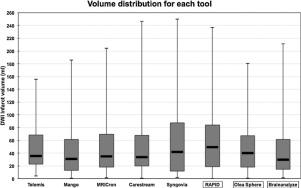Journal of Neuroradiology ( IF 3.0 ) Pub Date : 2020-03-11 , DOI: 10.1016/j.neurad.2020.03.002 Naim Khoury 1 , Cyril Dargazanli 2 , Kevin Zuber 3 , Stanislas Smajda 3 , Marie Bitar 4 , Grégoire Boulouis 5 , Wagih Ben Hassen 5 , Claire Ancelet 6 , Célina Ducroux 3 , Robert Fahed 7

|
Background and purpose
Recent clinical trials demonstrated the benefit of thrombectomy beyond 6 h based on the automated measurement of infarct volume exclusively with the RAPID software. We aimed to compare eight tools commonly used for the measurement of infarct volume and see whether they would lead to similar thrombectomy decisions based on the Diffusion-weighted-imaging or computerized-tomography-perfusion Assessment with clinical mismatch in the triage of Wake-up and late-presenting strokes undergoing Neurointervention with Trevo (DAWN) trial imaging inclusion criteria.
Materials and Methods
The diffusion-weighted-imaging (DWI) infarct volume of 36 patients was measured with 3 automated tools (including RAPID) and 5 non-automated tools. The agreement for the measurements of DWI infarct volume and the resulting thrombectomy decisions were assessed with intraclass correlation coefficient (ICC) and Fleiss’ Kappa (K) statistics.
Results
The correlation for the measurement of DWI infarct volume between all 9 tools was excellent (ICC > 0.8). After dichotomization, agreement was substantial for any of the cut-points used in DAWN trial. Discrepancies involving at least one of the tools for thrombectomy decisions based on DAWN criteria occurred in one third of cases. Compared with RAPID, the use of any other tool for treatment decision based on DAWN criteria would have led to contradictory decisions in 6% to 19% of cases.
Conclusion
There are several currently available tools for the measurement of DWI infarct volume with excellent correlation. Despite the high agreement demonstrated in our study, frequent discrepancies between measurements in some dichotomized configurations led to frequent diverging thrombectomy decisions when applying DAWN criteria.
中文翻译:

弥散加权成像梗塞体积测量工具显示出导致血栓切除决策分歧的差异
背景和目的
最近的临床试验证明了血栓切除术超过 6 小时的好处,这是基于仅使用 RAPID 软件自动测量梗塞体积。我们的目的是比较八种常用的梗塞体积测量工具,看看它们是否会导致基于弥散加权成像或计算机断层扫描灌注评估的类似血栓切除术决策与临床不匹配的唤醒和接受 Trevo 神经介入 (DAWN) 试验成像纳入标准的晚期中风。
材料和方法
使用 3 种自动化工具(包括 RAPID)和 5 种非自动化工具测量了 36 名患者的弥散加权成像 (DWI) 梗死体积。使用组内相关系数 (ICC) 和 Fleiss' Kappa (K) 统计量评估 DWI 梗死体积的测量和由此产生的取栓决定的一致性。
结果
所有 9 种工具之间 DWI 梗死体积测量的相关性非常好(ICC > 0.8)。在二分法之后,DAWN 试验中使用的任何分界点都具有实质性的一致性。在三分之一的病例中发生了涉及至少一种基于 DAWN 标准的血栓切除决策工具的差异。与 RAPID 相比,根据 DAWN 标准使用任何其他工具进行治疗决策会导致 6% 至 19% 的病例做出相互矛盾的决定。
结论
目前有几种可用的工具可用于测量 DWI 梗塞体积,并具有极好的相关性。尽管在我们的研究中证明了高度一致,但在应用 DAWN 标准时,某些二分配置中的测量值之间的频繁差异导致了频繁发散的血栓切除决定。











































 京公网安备 11010802027423号
京公网安备 11010802027423号